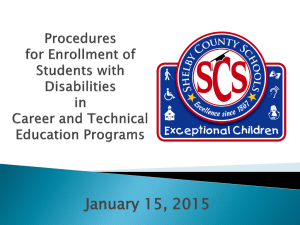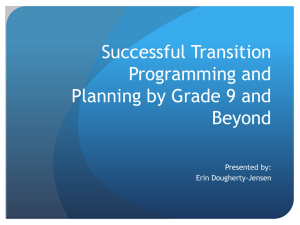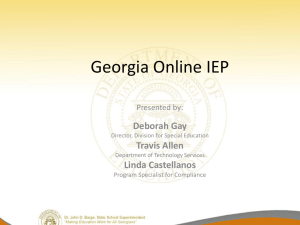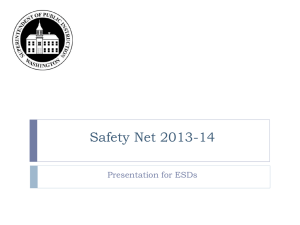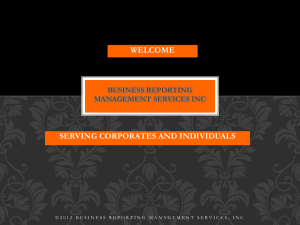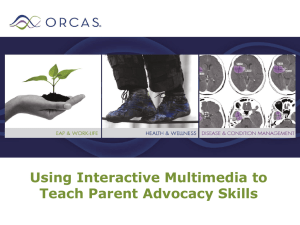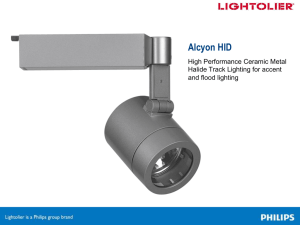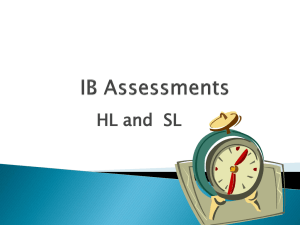Secondary Transition
advertisement
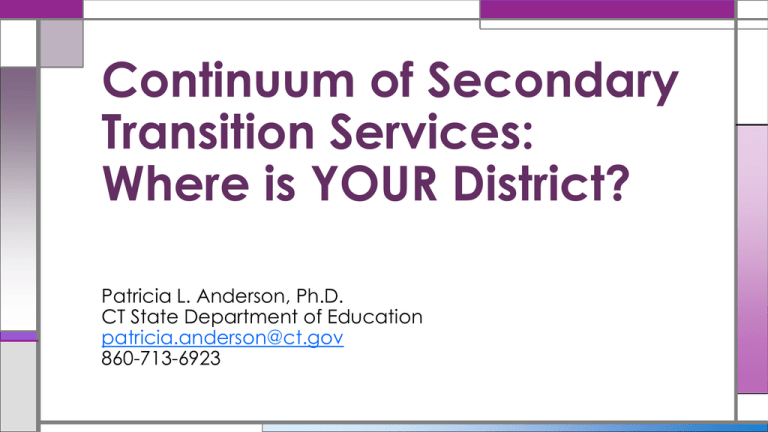
Continuum of Secondary Transition Services: Where is YOUR District? Patricia L. Anderson, Ph.D. CT State Department of Education patricia.anderson@ct.gov 860-713-6923 AGENDA Welcome and Announcements 2013-14 Indicator #13 Data Community-Based Transition Services Directory of Transition Services in College, University, and CommunityBased Settings – Directory Manager Guidelines Department of Labor Wage and Standards Agreement State Agency Changes [BRS/DDS] Teacher Course Student (TCS) Data Collection Spotlight on Secondary Transition – SERC Secondary Transition Planning IEP Checklist CORE Transition Skills Secondary Best Practices: “Above and Beyond Compliance” IEP Rubric for Secondary Transition Indicator #13 Cumulative Data School Year Indicator #13 # of LEAs Non- Compliance Percentage 2009 - 2010 77.8% 124 86.7% 2010-2011 93.8% 74 52% 2011-2012 99.7% 13 9.1% 2012-2013 99.98% 2 1.4% 2013-2014 99.7% 9* 6.29% Continuum of Secondary Transition Services: Where is YOUR District? While Connecticut’s compliance with Indicator #13 remains fairly consistent since 2012 (> 95% = substantial compliance), our student post-school outcomes responses have declined (22.7% - 2010 → 14.4% - 2013)! Are CT districts JUST meeting basic compliance standards or are we providing best practices in secondary transition? Community-Based Transition Services Directory of Transition Services in College, University, and Community-Based Settings – Revised 2014 35 settings that are 100% community-based Possibly 15 more sites to add Additional 18-21 transition services based within high schools CSDE Directory Manager – LEA Directory Certifier Guidelines Request for Waiver of Minimum Wage Requirements (CT Department of Labor ) Application form that must be submitted to the CT DOL to inform them that you coordinate community-based vocational training services for special education students. [Submit any time there are programmatic changes.] Specifies conditions under which LEAs do not have to compensate students in vocational training settings and defines an “employment relationship” for which a student must be compensated in accordance with CT General Statutes, Title 31. State Agency Changes – VR & WIOA Workforce Innovation & Opportunities Act (WIOA) – 2014 Replaces the Workforce Investment Act of 1998 (WIA) Amends the Rehabilitation Act of 1973 Emphasizes an increase in services to youth with disabilities Requires VR to make “pre-employment transition services” available Requires VR to set aside 15% of federal funds Redefines “Supported Employment” as integrated competitive employment or working on a short-term basis in an integrated setting towards goal of competitive employment Emphasizes “dual customer” approach where VR works with not only the consumer but also the employer – working more with businesses. State Agency Changes – BRS & WIOA BRS goal: to increase the number of Individualized Plans for Employment (IPEs) developed for eligible consumers within 90 days BRS will collaborate with LEAs to provide pre-employment transition services such as: Job exploration counseling Work-based learning experiences, Counseling on comprehensive transition or postsecondary education, Workplace readiness training, and Instruction in self-advocacy BRS will engage with students early and more often State Agency Changes – DDS Mission - The mission of the Department of Developmental Services is to partner with the individuals we support and their families, to support lifelong planning and to join with others to create and promote meaningful opportunities for individuals to fully participate as valued members of their communities. Vision – selected components Family Support – “Individuals have families who feel supported from the earliest years and throughout their lifetimes.” Lifelong Learning – “Have lifelong opportunities and the assistance to learn things that matter to them.” Money – “Earn money to facilitate personal choices.” Personal Responsibility – “Individuals make informed choices and take responsibility for their lives and experience the dignity of risk and that they know their rights and responsibilities and pursue opportunities to live the life they choose.” Services – Decrease in residential services/respite services - Emphasis on Positive Behavioral Support. State Agency Changes – DDS Five Year Plan (2012 - 2017) – selected goals Increase the number of individuals who are gainfully employed, including selfemployment and double the number of people who are competitively employed. Decrease the number of individuals in sheltered workshops and non-work day habilitation programs that are typically called day support options (DSO). Improve communication with families, providers, and staff (e.g., redesign DDS website, materials to help families to navigate the complex systems of DDS; available resources). Employment First – “Everyone can work and there is a job for everyone.” Real work for Real wages Integrated work environments with on-going support Family Website/School Years - http://www.ct.gov/dds/cwp/view.asp?a=2042&q=529448 Teacher Course Student (TCS) Data Collection The CT required TCS data collection connects Connecticut public school students to their teachers, along with information on courses completed and grades earned. Students who have completed graduation requirements and are 18 – 21 are included in this data collection via PSIS. [Transition ONLY] ONLY 477/702 (68%) were recently reported in TCS! ONLY 93 of those students reported Workplace Credit! TCS provides data on all special education students including 18-21 yearolds. There are NCES course codes that indicate life skills, off-site work courses/experiences, etc. Indicating that the student is earning 0.00 credits and that the grade is “pass” is acceptable and should not prevent a student and the “course” from being submitted. CRITICAL down the road! - TCS may soon be used as an “expanded accountability” indicator to document a district’s “college and career readiness.” Contact your Special Education Director and/or District TCS Contact for more information or assistance in getting your transition students into the TCS database (http://www.csde.state.ct.us/public/tcs/). Spotlight on Transition http://ctserc.org/transitionspotlight Secondary Transition Planning IEP Checklist Tool to ensure that all components of Indicator #13 compliance have been addressed for every transition-age student via the IEP. Corrective action for 2012-13 (2 districts) All secondary case managers do at least one IEP Submit IEP and checklist for 25% of case managers Lessons learned: Not all PSOGSs written using measurable language Some IEPs did not have both a Postsecondary Education/Training and an Employment PSOGS and/or Annual Goal/Objective New information for some case managers Corrective action for 2013-14 (9 districts) Best Practices – Only one district reported using Checklist on a regular basis Review IEP with Secondary Transition IEP Checklist 1. Use the IEP that you brought with you or the one provided on the SERC website/table. 2. Using the Secondary Transition IEP Checklist – review how your IEP compares to the recommended elements. 3. Items 1, 2, 25 & 26 are not recorded on the IEP. Have a conversation at your table about how your district is handling these transition related requirements. 4. You will have 15 minutes to review your IEP. 5. Be prepared to share with your table or the larger group what you learned about writing appropriate IEPs for transition age students. CT Core Transition Skills A. Assist with the development of his/her Individualized Education Program (IEP). B. Attend, participate in and/or facilitate his/her Planning and Placement Team (PPT) meeting. C. Demonstrate and accept responsibility for his/her independence and activities of daily living. D. Demonstrate skills needed to access appropriate transportation (both public and private). CT Core Transition Skills E. Explain his/her disability relative to individual strengths, needs, preferences and interests. F. Identify and ask for accommodations necessary to ensure equal access and full participation in postschool education and/or employment settings. G. Describe his/her rights and responsibilities under disability legislation (e.g., IDEA, 504, ADA). H. Demonstrate skills to access appropriate healthcare to meet his/her individual needs. CT Core Transition Skills I. Demonstrate skills to access community resources and participate in the community with and without support (recognizing the need for interdependence). J. Demonstrate skills to access appropriate employment to meet his/her individual needs. K. Demonstrate skills to access appropriate postsecondary education, training, or lifelong learning opportunities to meet his/her individual needs. L. Demonstrate appropriate social interactions and skills to develop and maintain meaningful relationships. Secondary Best Practices: “Above and Beyond Compliance” Response Rate: 36/143 = 25% 16 Best Practices (2 or more LEAs) Most frequent responses: Community-Based Transition Services “Fifth-year”/”Bridge-year” Services College Courses/Partnerships with Higher Education Use of CORE Transition Skills to write IEP goals & objectives Person-Centered Planning 17 additional unique Best Practices Secondary Best Practices: “Above and Beyond Compliance” OTHER Best Practices: “We are not doing any of these things consistently – only on a case-by-case basis. I am going to use this as a motivation to push transition forward.” “Thank you for the many reminders. We get so caught up in the day-to-day stuff we forget to stop and look at the great things we are doing.” IEP Rubric for Secondary Transition 1. Use the IEP that you brought with you or the IEP posted on the SERC website or on your table. 2. As a table, use the IEP Rubric for Secondary Transition to “score” the IEP. 3. Jot down on the Rubric: Issues that need further clarification/definition. Questions that you have about the scoring process. Areas that you feel should be added to a particular component. 4. Please leave your Rubric with comments for us to use as we revise the DRAFT. You can access a blank Rubric on the SERC website. 5. Use the colored form “IEP Rubric for Secondary Transition - Notes on Reflection” to make notes about practices that you discover in this process that you want to keep and those that you want to change. Bring this information back to your district to use in future planning. Secondary Transition Initiatives CT Transition Community of Practice Website Development & Resources Statewide Interagency Training & Events Secondary Transition Timeline Disability Employment Initiative Grants – DOL Greater Hartford & Waterbury/Danbury/Torrington Employment for Adults with Disabilities (18 and up) Interact with Community-Based 18-21 transition services Transition Resources Currently posted on SERC Website: (http://ctserc.org/bts14docs) • 2014 Secondary Transition Best Practices.pdf • CT CORE Transition Skills FINAL 8-1-13.pdf • Sample Redacted IEP - Transition.pdf • Secondary Transition IEP Rubric-Final.pdf • Transition Plng Checklist - REV3 3-20-14.doc CORE Transition Skills and BRS Transition Resources Guideposts for Success – CT’s Transition Framework CT Transition Community of Practice (www.sharedwork.org) CORE Transition Skills A. Assist with the development of his/her Individualized Education Program (IEP). Guidepost for Success 1 BRS Resources B. Attend, participate in and/or facilitate his/her Planning and Placement Team (PPT) meeting. 1 C. Demonstrate and accept responsibility for his/her independence and activities of daily living. 3 Assessments ( i.e., WOWI, Picture Personality Inventory, Reading Free, Myers Briggs, Strong, Card Sorts, CAI, O*NET) Portfolio development Student Success Plan- Collaborate with school http://www.sde.ct.gov/sde/lib/sde/PDF/DEPS/Special/ED635.pdf IEP/IPE Crosswalk -http://www.ct.gov/brs/lib/brs/pdfs/guidepostdocs/BRSIEPResource.pdf Stepping Forward: A Self-Advocacy Guide for Middle and High School Students http://www.ct.gov/brs/lib/brs/pdfs/guidepostdocs/steppingforward_color_interactive_14. pdf 411 on Disability Disclosure http://www.ct.gov/brs/lib/brs/pdfs/guidepostdocs/411DisabilityDisclosureComplete.pdf Building a Bridge http://www.sde.ct.gov/sde/lib/sde/PDF/DEPS/Special/BuildingABridge.pdf Functional Limitations Checklist Understanding the role of an outside participating agency (Concept) Connect Ability E Learning: https://elearning.connect-ability.com/ o IL Overview, PAS, Service Animals, Emergency Preparedness Collaborate with Mental Health Providers o DMHAS, LMHA, YAS, NAMI Healthy and Ready to Work http://www.findyouthinfo.gov/youth-topics Look at ALL activities through a transition lens.

